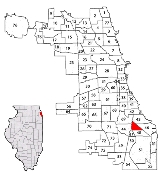
Avalon Park, Chicago
Encyclopedia
Avalon Park, located on the south side of the U.S.
city of Chicago, Illinois, is one of the city's 77 official community areas
and a park. Boundaries are 76th St. to the north, South Chicago Ave. to the east and 87th St. to the south. The community area includes the neighborhoods of Avalon Park, Marynook and Stony Island Park.
" that many other Chicago neighborhoods experienced: the average educational level increased, while the poverty rate decreased from 6.1% to 5.1% between 1960 and 1970. Unlike in some other rapidly changing neighborhoods, the homeownership rate remained high – still above 70%, as it has been since 1950. In the 1980 census, 59% of the population were employed in white-collar occupations; this rose to 65% in the 2000 census.
(Source: "There Goes the Neighborhood: Racial, ethnic, and class tensions in four Chicago neighborhoods and their meaning for America
" by William Julius Wilson
and Richard P. Taub; 2006. The book gives Avalon Park a pseudonym
of "Groveland")
United States
The United States of America is a federal constitutional republic comprising fifty states and a federal district...
city of Chicago, Illinois, is one of the city's 77 official community areas
Community areas of Chicago
Community areas in Chicago refers to the work of the Social Science Research Committee at University of Chicago which has unofficially divided the City of Chicago into 77 community areas. These areas are well-defined and static...
and a park. Boundaries are 76th St. to the north, South Chicago Ave. to the east and 87th St. to the south. The community area includes the neighborhoods of Avalon Park, Marynook and Stony Island Park.
History
Avalon Park experienced a major demographic change in the 1960s. In the 1960 census, Avalon Park was 0% African American (only six of 12,710 residents). A decade later, Avalon Park was 83% African American, according to the 1970 census. The African American population continued to increase, making up 98% of the residents by 1990. The change in the neighborhood was different from the "white flightWhite flight
White flight has been a term that originated in the United States, starting in the mid-20th century, and applied to the large-scale migration of whites of various European ancestries from racially mixed urban regions to more racially homogeneous suburban or exurban regions. It was first seen as...
" that many other Chicago neighborhoods experienced: the average educational level increased, while the poverty rate decreased from 6.1% to 5.1% between 1960 and 1970. Unlike in some other rapidly changing neighborhoods, the homeownership rate remained high – still above 70%, as it has been since 1950. In the 1980 census, 59% of the population were employed in white-collar occupations; this rose to 65% in the 2000 census.
(Source: "There Goes the Neighborhood: Racial, ethnic, and class tensions in four Chicago neighborhoods and their meaning for America
There Goes the Neighborhood (book)
There Goes the Neighborhood by William Julius Wilson and Richard Taub was written in 2006 and is an investigation about racial, ethnic and class tensions in four Chicago neighborhoods. The four neighborhoods, Beltway, Dover, Archer Park, and Groveland are found on the south and west side of Chicago...
" by William Julius Wilson
William Julius Wilson
William Julius Wilson is an American sociologist. He worked at the University of Chicago 1972-1996 before moving to Harvard....
and Richard P. Taub; 2006. The book gives Avalon Park a pseudonym
Pseudonym
A pseudonym is a name that a person assumes for a particular purpose and that differs from his or her original orthonym...
of "Groveland")

